热成像测温方案
热成像测温系统解决方案

热成像测温系统可以通过非接触的方式检测人体温度,能够帮助用户快速发现体温异常的人员。
今天就来给大家介绍一下相关的解决方案。
系统框架围绕公共卫生突发事件下的人体测温预警管控业务建设要求,系统提供两种应用模式。
一种是快速布控筛查方案,一种是手持体温筛查方案。
1、快速布控筛查方案该模式主要用于对人流量较大的单个站点或出入口,快速布设本地组网的热成像测温摄像机,通过计算机上的报警管理软件进行人行通道的测温监测和实时报警。
对于突发公共卫生事件下,该模式可以用于对公共人员快速实施无感测温,主动发现异常体温人员,提高应急事件响应效率。
2、手持体温筛查方案该模式下,为了便于执法人员机动灵活的对各个通道口的人员进行实时检查。
系统设计采用活体手持测温热像仪对待检人员进行测温,快速查看图像和数据。
3、技术原理自然界中,一切物体只要其温度高于绝对零度(-273℃)都能辐射电磁波。
热成像主要采集热红外波段(8μm-14μm)的光,来探测物体发出的热辐射。
热成像把热辐射转化为灰度值,通过黑体辐射源标定得到的测温算法模型(温度灰度曲线)建立灰度与温度的准确对应关系,从而来实现测温功能。
4、热成像体温筛查:热成像体温筛查是指通过热像仪(非接触式方式)初步对人体表面温度进行检测,超过正常体温即判断存在发烧的可能性,这种情况下建议复测;复测方法,建议使用耳温枪或者水银温度计测温。
热成像相机通过检测人表面的热辐射进行测温,测温结果也会随着流汗或者风吹出现波动,因此热成像体温筛查系统建议用于室内相对稳定环境。
现在很多客运站、火车站、地铁开始安装热成像测温系统,如果说大家想多了解一下这个系统,成都慧翼科技建议大家找专业人士咨询一下。
红外成像测温方法介绍

红外成像测温方法介绍随着科技的进步,红外成像测温技术在各行各业中得到了广泛的应用。
该技术通过检测物体所发出的红外辐射来测量其表面温度,具有非接触、快速、准确的优点。
本文将介绍几种常见的红外成像测温方法。
一、红外测温原理红外成像测温的基本原理是物体受热后会发出热辐射,其中包括了红外辐射。
红外相机能够将红外辐射转化为热图像,通过分析热图像的颜色和亮度来确定物体表面的温度分布情况。
二、热像仪法热像仪法是最常见的红外成像测温方法之一。
它利用红外相机捕捉物体发出的红外辐射,将其转化为热图像。
热图像以不同的颜色来表示物体的温度,通常采用热色谱图来显示。
热像仪可以快速扫描大面积,适用于工业生产线上的温度检测以及建筑结构的热损失分析等。
三、红外测温仪法红外测温仪是一种手持式温度测量设备,可以单点或多点测温。
它通常包括一个红外探测器和一个显示屏。
其原理是通过接收物体表面所发出的红外辐射,转化为温度数值并显示出来。
红外测温仪可以实时测温,非常适用于工业领域中的温度监测,如电力设备、管道、锅炉等的故障诊断。
四、红外测温系统红外测温系统是一种集成了红外成像和温度测量功能的设备。
它通常由红外相机、控制器和显示屏组成。
红外相机负责捕捉物体的红外辐射,并转化为热图像。
控制器负责对热图像进行分析处理,计算出物体表面的温度。
显示屏则显示热图像和温度数值。
红外测温系统可以用于大范围的温度监测,如火灾报警系统、医疗诊断等。
五、红外测温的应用领域红外成像测温技术在各个行业中都有广泛的应用。
在工业领域,它可以用于故障诊断、设备运行状态监测等;在医疗领域,它可以用于体温检测、疾病诊断等;在建筑领域,它可以用于检测建筑结构的热损失情况等。
此外,红外测温技术还可以应用于夜视、安防等领域。
总结:红外成像测温技术以其非接触、快速、准确的特点,被广泛应用于各个行业中。
热像仪法、红外测温仪法以及红外测温系统等几种常见的测温方法,能够满足不同领域对温度测量的需求。
热成像人体测温解决方案
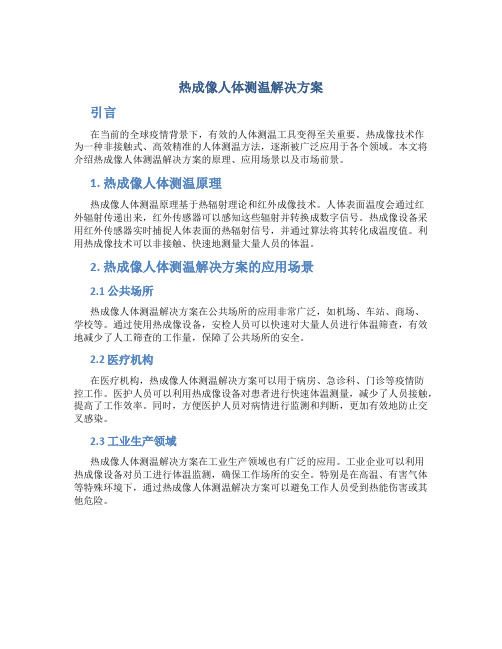
热成像人体测温解决方案引言在当前的全球疫情背景下,有效的人体测温工具变得至关重要。
热成像技术作为一种非接触式、高效精准的人体测温方法,逐渐被广泛应用于各个领域。
本文将介绍热成像人体测温解决方案的原理、应用场景以及市场前景。
1. 热成像人体测温原理热成像人体测温原理基于热辐射理论和红外成像技术。
人体表面温度会通过红外辐射传递出来,红外传感器可以感知这些辐射并转换成数字信号。
热成像设备采用红外传感器实时捕捉人体表面的热辐射信号,并通过算法将其转化成温度值。
利用热成像技术可以非接触、快速地测量大量人员的体温。
2. 热成像人体测温解决方案的应用场景2.1 公共场所热成像人体测温解决方案在公共场所的应用非常广泛,如机场、车站、商场、学校等。
通过使用热成像设备,安检人员可以快速对大量人员进行体温筛查,有效地减少了人工筛查的工作量,保障了公共场所的安全。
2.2 医疗机构在医疗机构,热成像人体测温解决方案可以用于病房、急诊科、门诊等疫情防控工作。
医护人员可以利用热成像设备对患者进行快速体温测量,减少了人员接触,提高了工作效率。
同时,方便医护人员对病情进行监测和判断,更加有效地防止交叉感染。
2.3 工业生产领域热成像人体测温解决方案在工业生产领域也有广泛的应用。
工业企业可以利用热成像设备对员工进行体温监测,确保工作场所的安全。
特别是在高温、有害气体等特殊环境下,通过热成像人体测温解决方案可以避免工作人员受到热能伤害或其他危险。
3. 热成像人体测温解决方案的优势3.1 高效快速热成像人体测温解决方案可以实现对大量人员的快速测温,非接触式的优势使得人员筛查更加高效。
传统的体温测量方法需要一个一个地接触式测量,非常耗时耗力。
3.2 精准可靠热成像技术可以实现对人体表面温度的高精度测量,智能的算法可以将热辐射信号转化为温度值,非常可靠。
相比于传统的体温计测量方法,热成像人体测温解决方案减少了测量误差,提高了测量的准确性。
发电行业热成像测温系统解决方案
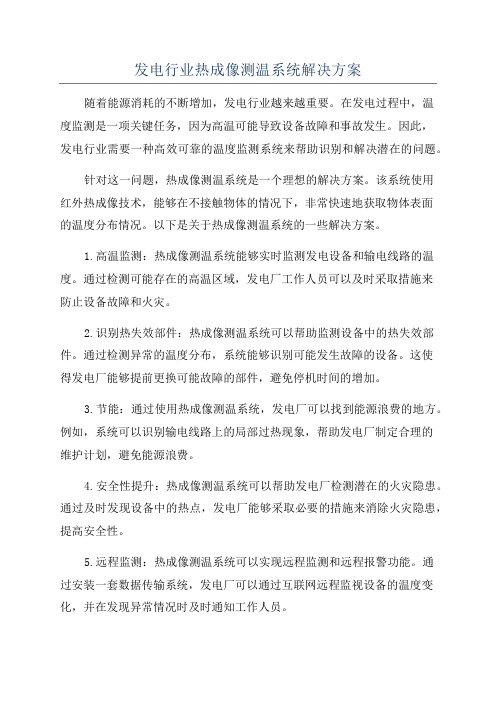
发电行业热成像测温系统解决方案随着能源消耗的不断增加,发电行业越来越重要。
在发电过程中,温度监测是一项关键任务,因为高温可能导致设备故障和事故发生。
因此,发电行业需要一种高效可靠的温度监测系统来帮助识别和解决潜在的问题。
针对这一问题,热成像测温系统是一个理想的解决方案。
该系统使用红外热成像技术,能够在不接触物体的情况下,非常快速地获取物体表面的温度分布情况。
以下是关于热成像测温系统的一些解决方案。
1.高温监测:热成像测温系统能够实时监测发电设备和输电线路的温度。
通过检测可能存在的高温区域,发电厂工作人员可以及时采取措施来防止设备故障和火灾。
2.识别热失效部件:热成像测温系统可以帮助监测设备中的热失效部件。
通过检测异常的温度分布,系统能够识别可能发生故障的设备。
这使得发电厂能够提前更换可能故障的部件,避免停机时间的增加。
3.节能:通过使用热成像测温系统,发电厂可以找到能源浪费的地方。
例如,系统可以识别输电线路上的局部过热现象,帮助发电厂制定合理的维护计划,避免能源浪费。
4.安全性提升:热成像测温系统可以帮助发电厂检测潜在的火灾隐患。
通过及时发现设备中的热点,发电厂能够采取必要的措施来消除火灾隐患,提高安全性。
5.远程监测:热成像测温系统可以实现远程监测和远程报警功能。
通过安装一套数据传输系统,发电厂可以通过互联网远程监视设备的温度变化,并在发现异常情况时及时通知工作人员。
总之,热成像测温系统是解决发电行业温度监测问题的理想解决方案。
它能够帮助发电厂识别高温区域、检测热失效部件、节能、提升安全性以及实现远程监测和报警功能。
这些功能使发电厂能够更好地管理和维护设备,确保发电过程的顺利进行。
热成像测温技术
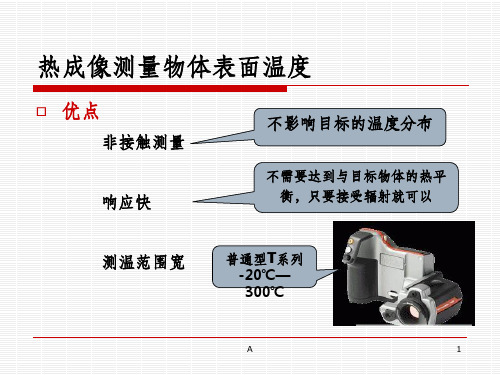
被测物体辐射的能量
响应平面 大气
A
探 测 器
红外热成像仪
4
热成像测量物体表面温度
工作波长的选择
依据:测量温度的范围、被测物体的发射率、大气传输 ⑴依据测量温度的范围选择
红外辐射覆盖的温度范围为-272℃一3571℃
物体的温度越高 辐射能量越大
高温测量--选短波 低温测量--选长波 中温测量—中间波
A
2
热成像测量物体表面温度
测温影响因素
⑴被测物体发射率 发射率又称为黑度,反映物体向外发射辐射的能 力.物体表面发射率是不相同,且随温度和波长变化。
A
3
热成像测量物体表面温度
⑵背景
被测物体的辐射能
背景投向物体表面被物体 物体表面反射的辐射能
背景投向物体表面并透过物 体物体表面的辐射能
⑶大气
某些成分吸 收红外辐射
应用
⑴在电力行业中的应用
A
9
热成像测量物体表面温度
应用
⑵在微电子行业中的应用
A
10
热成像测量物体表面温度
应用
⑶ 机械故障诊断
A
11
热成像测量物体表面温度
应用
⑷野生动物
A
12
热成像测量物体表面温度
应用
⑸夜视监视
A
13
热成像测量物体表面温度
应用
⑹在军事上的应用
A
14
A
5
热成像测量物体表面温度
工作波长的选择
⑵依据被测物体的发射率选择
对于发射率既随温度变化又随波 长变化的物体,主要依据发射率随 温度的变化。
⑶依据大气窗口选择
如右图光谱图可知:透射率很好或较 好的区域为可见光波长为: 0.76μm—1.1μm 1.2μm一1.3μm 1.6μm一1.75μm
红外热成像仪的操作指南和热图解析方法

红外热成像仪的操作指南和热图解析方法红外热成像仪是一种高精度的测温设备,它可以通过红外技术来测量物体表面的温度分布,并将其转化为可视化的热图。
由于其在工业探测、医疗诊断、环境监测等领域具有广泛的应用,本文将为大家介绍红外热成像仪的操作指南和热图解析方法。
首先,我们来了解红外热成像仪的基本操作流程。
在使用前,首先需要将红外热成像仪打开,并进行预热。
预热时间一般为十几分钟,这是因为红外热成像仪需要在稳定的热平衡状态下进行工作,以保证测量的准确性。
在红外热成像仪预热完毕后,我们需要设置一些基本参数,如测量的距离、测温范围、测量的时间等。
测量距离一般根据需要进行调整,一般来说,距离越近,分辨率越高,但测量范围相对较小;反之,距离越远,分辨率越低,但测量范围相对较大。
测温范围则需要根据被测物体的温度情况来设定,一般来说,红外热成像仪的测温范围为-20℃至+1500℃。
此外,我们还可以设置红外热成像仪的测量时间,一般来说,测量时间越长,测量结果越精准。
当设置好基本参数后,我们可以将红外热成像仪对准被测物体,并进行测量。
在测量过程中,需要注意保持红外热成像仪与被测物体之间的相对稳定,避免晃动导致测量结果的不准确。
此外,我们还需要选择合适的测量模式,如单点测温、区域测温、高温报警等。
不同的测量模式适用于不同的场景,我们可以根据需要进行选择。
完成测量后,红外热成像仪会生成一个热图。
热图会以不同颜色的像素点来表示不同温度的区域,一般来说,高温区域使用红色或白色表示,低温区域使用蓝色或黑色表示。
通过观察热图,我们可以分析被测物体的温度分布情况。
在热图的解析中,我们需要注意以下几个方面。
首先,我们可以通过热图来判断不同区域的温度差异,从而找出问题所在。
例如,当在工业设备中出现局部过热的情况时,我们可以通过热图直观地观察到相应区域的高温区域。
其次,我们可以通过热图来进行定量分析。
红外热成像仪通常会提供每个像素点的温度数值,我们可以通过对热图进行统计分析,得出不同区域的平均温度、最高温度等信息。
Hikvision 体温检测热像解决方案简介说明书
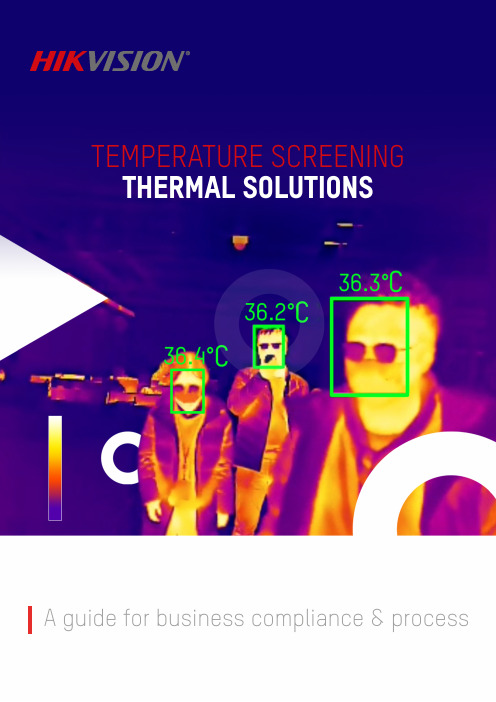
TEMPERATURE SCREENINGA guide for business compliance & processHIKVISION TEMPERATURE SCREENINGTHERMAL SOLUTIONS INTRODUCTIONThis eGuide has been designed as an aid for businesses to gather basic considerations for the process and implementation of temperature screening thermal solutions. Each business context and execution will be unique, so this guide is only meant to direct companies with key concerns. This document does not address every possible situation for all organisations and sizes. It is a guide and each element of the process of installing and implementing a thermal image camera in your organisation needs to be tailored to your business, environment and policies. Each business is advised to seek legal counsel where appropriate to answer the unique aspects and individual requirements.This temperature screening thermal solution provides a fast overview of the surface skin temperature of all persons, entering a building/facility.Hikvision are deploying temperature screening systems across a wide range of industries including:• Detect the surface skin temperature of a person on a ‘non-contact’ basis thereby reducing risk.• Offer an indication when the temperature detected is outside of the ‘normal’ range set on installation, thereby providing a first line of screening of people entering a facility.• Provide screening of a high volume of people in a short timeframe making for an efficient process.• Provide an organisation with an audit trail of steps taken to assist with ensuring the Health, Safety and Welfare of both staff and visitors as screening images can be recorded andretained (not via handheld units) if required.What our Thermal Screening Cameras CAN DO- Hospitals - Enterprise Head Offices- Construction Sites - Government Buildings- Medical Universities - Food distribution centres- Nursing Homes - Drug distribution centres- Meat Processing Plants - Retail Stores- Large commercial offices - Restaurants• Detect the Corona Virus • Detect a FeverWhat our Thermal Screening Camera CANNOT DO• Company approval – HR Director / IT Director / Facilities / Infection Control / Data officer • HikVision Thermal Camera – linked to a fully charged laptop (and recorder if required)• How to manage the operation / Guidance on getting set up • Best practice communication templates to inform your people • A data protection impact assessment What’s required in order to set up an effective compliant screening process?• Solution choices and video overview – https:///uk/solutions/solutions-by-application/temperature-screening/• Live Webinar presentations – https:///uk/support/webinars/ • Product information – https:///uk/products/Thermal-Products/Thermography-thermal-cameras/temperature-screening-series/Providing Effective Training - HikVision online training video and supportConsideration should be given to who is being screened. If this is just your own staff, then the process should be relatively easy to implement. Consent should be obtained from each employee by the completion of a simple form on the first day of their return (or in advance via HR & your internal communications team).Guidance on the Appropriate Communication - Letting your staff know and understand the reason & purpose for the new screening process• Consideration needs to be given and a policy introduced for the effective screening and management of visitors to the facility. • Who is going to be present to monitor the screening and to pick up any events triggered by high temperature readings? Security / Reception / HR administrator • Will the person need to be trained in managing potential conflict if members of the public object to either being screened or asked to undertake further screening etc. ?• Will the visitor be asked to leave or to undergo further screening by use of a thermometer? • What facility will be made available to that person? • Prepare an Isolated area / organise a clean room for elevated temperature cases or employees who are feeling unwell.Scenarios you need to prepare for:NOTE OF IMPORTANCE:If an employee/visitor comes in from a hot day or have been rushing, they may just be running a little hot! There should be an opportunity for them to wait in an area and then be re-screened? NB: Thermal screening should only be conducted in an indoor environment, in stable temperature conditions and be free from the effects of sunlight, wind etc… placement of the kit, and funnelling of people through the process is a critical factor.GDPR considerationsThe use of today’s video techniques often requires privacy/GDPR consideration. Video techniques like facial recognition reveal ‘personal data’, which is defined as ‘processing personal data’ and privacy regulations like GDPR, apply. The data of a human subjects body temperature generated during automated temperature measurement is not defined as a ‘personal data’ in GDPR. However, it cannot be ruled out that data protection law applies if it is possible (even subsequently) to identify the persons passing the cameras. Processing of “data concerning health” is prohibited by GDPR unless you can demonstrate you satisfy certain legal grounds.We have endeavoured to optimise our products and helped our customers to reduce the compliance risks on data protection law. However, it is still important for you to check out the legislation and government guidance for your business regularly, given things are changing all the time.The lawfulness of your temperature screening is likely to stand or fall on whether you can make out one the exceptional legal grounds, even though they are not absolute. You should be responsible to make sure if they suit your business, and seek legal advice if necessary.The legal grounds with most potential are:(1) employment law rights and obligationsEmployers have a legal obligation to protect the health of their employees under employment law, and employees also have a duty to take reasonable care to protect their health and the health of any other person in the workplace. In this regard, employers would be justified in requiring employees to inform them if they have a medical diagnosis of COVID-19 in order to allow necessary steps to be taken. However, an employer is not allowed to take measures which are not necessary or appropriate. Engagement in temperature checks for all the employees usually is seemed as unnecessary.(2) explicit consentEmployees can provide explicit consent but meanwhile they must be able to refuse a temperature screening without detriment. This may prevent a universal application of temperature screening policy, which ultimately defeats its purpose.(3) health (occupational medicine) and public healthU nder certain conditions, the processing of sensitive data is permissible if it concerns the “substantial public interest” in the area of public health, which includes in particular “serious cross-border threats to health” and “ensuring high standards of quality and safety in health care and in medicinal products and medical devices”.Please notice that any personal data you collect to satisfy the grounds above should be proportionate for that purpose. You should not collect more than you need, and it should be managed appropriately. As with other aspects of good data protection practice, you should record the decisions you make and the rationale for them if possible.For sales information please contact:Email: ********************** | Website: About Hikvision – Hikvision is a world leading provider of security products and solutions. Featuring an extensive and highly skilled R&D workforce, Hikvision manufactures a full suite of comprehensive products and solutions for a broad range of vertical markets. In addition to the security industry, Hikvision extends its reach to smart home tech, industrial automation, and automotive electronics industries to achieve its long-term vision. Hikvision products also provide powerful business intelligence for end users, which can enable more efficient operations and greatercommercial success.。
热成像 算法
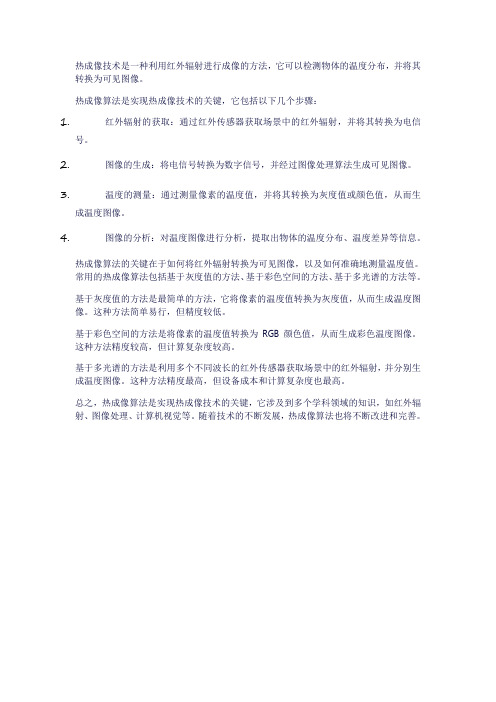
热成像技术是一种利用红外辐射进行成像的方法,它可以检测物体的温度分布,并将其转换为可见图像。
热成像算法是实现热成像技术的关键,它包括以下几个步骤:
1.红外辐射的获取:通过红外传感器获取场景中的红外辐射,并将其转换为电信
号。
2.图像的生成:将电信号转换为数字信号,并经过图像处理算法生成可见图像。
3.温度的测量:通过测量像素的温度值,并将其转换为灰度值或颜色值,从而生
成温度图像。
4.图像的分析:对温度图像进行分析,提取出物体的温度分布、温度差异等信息。
热成像算法的关键在于如何将红外辐射转换为可见图像,以及如何准确地测量温度值。
常用的热成像算法包括基于灰度值的方法、基于彩色空间的方法、基于多光谱的方法等。
基于灰度值的方法是最简单的方法,它将像素的温度值转换为灰度值,从而生成温度图像。
这种方法简单易行,但精度较低。
基于彩色空间的方法是将像素的温度值转换为RGB颜色值,从而生成彩色温度图像。
这种方法精度较高,但计算复杂度较高。
基于多光谱的方法是利用多个不同波长的红外传感器获取场景中的红外辐射,并分别生成温度图像。
这种方法精度最高,但设备成本和计算复杂度也最高。
总之,热成像算法是实现热成像技术的关键,它涉及到多个学科领域的知识,如红外辐射、图像处理、计算机视觉等。
随着技术的不断发展,热成像算法也将不断改进和完善。
彩页—大华热成像人体测温方案

-20°
像人
精度
达±
0
.
3
°
C
异常体温筛查 智能联动
安全通行
三重防夹
坚固耐用
不锈钢机身
适用场景
检查站、车站、机场、医院、学校、酒店、政府机关等 需要监测体温、控制人流的场所
「 让社会更安全 让生活更智能 」
ENABLING A SAFER SOCIETY AND SMARTER LIVING
适应性强
可回溯
可适用于出入口、门店等小场景以及三站一场等人员密集的大场景 结合平台,可实现对历史数据的回溯,数据分析等
测温产品
人体测温双目中枪 DH-TPC-BF3221
人体测温双目球 DH-TPC-SD8421 热成像人体测温黑体 DH-TPC-HBB1
智能温感人行通道
技术参数
氧化钒非制冷红外焦平面探测器
探测器分辨率 256*192
光谱范围
8μm~14μm
热成像镜头 3.5mm/7mm可选
灵敏度
<50 mK
可见光探测器
靶面尺寸
1/2.8“ CMOS
镜头焦距
4mm/8mm可选
功能规格
声光警戒
内置白光警示灯、喇叭
测温范围
30℃~45℃
测温精度
±0.3℃,有黑体;±1℃,无黑体
技术参数
探测器分辨率 光谱范围 热成像镜头 灵敏度
性能规格 40.0℃(环温+5.0℃~ 50.0℃可调) 0.1℃ ±0.2℃(单点) ±( 0.1~0.2 )℃/30min 0.97±0.02 220VAC 50Hz 0~40℃/ ≤80%RH
技术参数
性能规格
测温范围
Hikvision 体温检测热成像解决方案介绍说明书
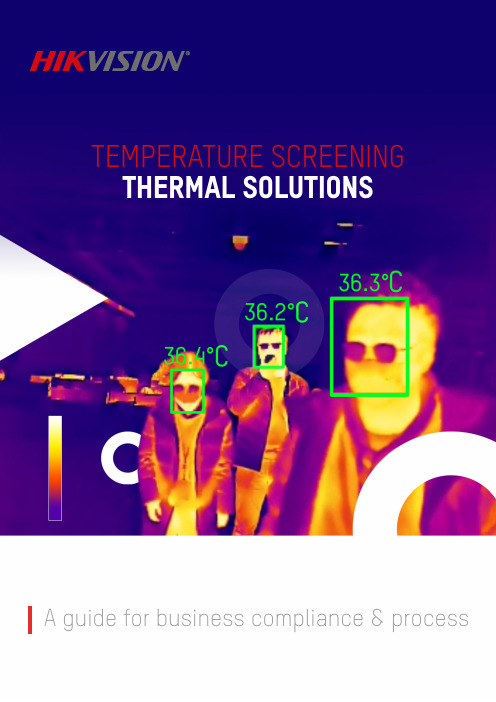
TEMPERATURE SCREENINGA guide for business compliance & processHIKVISION TEMPERATURE SCREENINGTHERMAL SOLUTIONS INTRODUCTIONThis eGuide has been designed as an aid for businesses to gather basic considerations for the process and implementation of temperature screening thermal solutions. Each business context and execution will be unique, so this guide is only meant to direct companies with key concerns. This document does not address every possible situation for all organisations and sizes. It is a guide and each element of the process of installing and implementing a thermal image camera in your organisation needs to be tailored to your business, environment and policies. Each business is advised to seek legal counsel where appropriate to answer the unique aspects and individual requirements.T his temperature screening thermal solution provides a fast overview of the surface skin temperature of all persons, entering a building/facility. Thermal technology is just one tool in a selection of technologies available which should be used in conjunction with government advice to always follow social distancing guidelines, wear a face mask on public transport and enclosed public spaces, and regularly wash hands.Hikvision are deploying temperature screening systems across a wide range of industries including:• Detect the surface skin temperature of a person on a ‘non-contact’ basis thereby reducing risk.• Offer an indication when the temperature detected is outside of the ‘normal’ range set on installation, thereby providing a first line of screening of people entering a facility.• Provide screening of a high volume of people in a short timeframe making for an efficient process.• Provide an organisation with an audit trail of steps taken to assist with ensuring the Health, Safety and Welfare of both staff and visitors as screening images can be recorded andretained (not via handheld units) if required.What our Thermal Screening Cameras CAN DO- Hospitals - Enterprise Head Offices- Construction Sites - Government Buildings- Medical Universities - Food distribution centres- Nursing Homes - Drug distribution centres- Meat Processing Plants - Retail Stores- Large commercial offices - Restaurants• Detect the Corona Virus • Detect a FeverWhat our Thermal Screening Camera CANNOT DO• Company approval – HR Director / IT Director / Facilities / Infection Control / Data officer • HikVision Thermal Camera – linked to a fully charged laptop (and recorder if required)• How to manage the operation / Guidance on getting set up • Best practice communication templates to inform your people • A data protection impact assessment What’s required in order to set up an effective compliant screening process?• Solution choices and video overview – https:///uk/solutions/solutions-by-application/temperature-screening/• Live Webinar presentations – https:///uk/support/webinars/ • Product information – https:///uk/products/Thermal-Products/Thermography-thermal-cameras/temperature-screening-series/Providing Effective Training - HikVision online training video and supportConsideration should be given to who is being screened. If this is just your own staff, then the process should be relatively easy to implement. Consent should be obtained from each employee by the completion of a simple form on the first day of their return (or in advance via HR & your internal communications team).Guidance on the Appropriate Communication - Letting your staff know and understand the reason & purpose for the new screening process• Consideration needs to be given and a policy introduced for the effective screening and management of visitors to the facility. • Who is going to be present to monitor the screening and to pick up any events triggered by high temperature readings? Security / Reception / HR administrator • Will the person need to be trained in managing potential conflict if members of the public object to either being screened or asked to undertake further screening etc. ?• Will the visitor be asked to leave or to undergo further screening by use of a thermometer? • What facility will be made available to that person? • Prepare an Isolated area / organise a clean room for elevated temperature cases or employees who are feeling unwell.Scenarios you need to prepare for:NOTE OF IMPORTANCE:If an employee/visitor comes in from a hot day or have been rushing, they may just be running a little hot! There should be an opportunity for them to wait in an area and then be re-screened? NB: Thermal screening should only be conducted in an indoor environment, in stable temperature conditions and be free from the effects of sunlight, wind etc… placement of the kit, and funnelling of people through the process is a critical factor.GDPR considerationsThe use of today’s video techniques often requires privacy/GDPR consideration. Video techniques like facial recognition reveal ‘personal data’, which is defined as ‘processing personal data’ and privacy regulations like GDPR, apply. The data of a human subjects body temperature generated during automated temperature measurement is not defined as a ‘personal data’ in GDPR. However, it cannot be ruled out that data protection law applies if it is possible (even subsequently) to identify the persons passing the cameras. Processing of “data concerning health” is prohibited by GDPR unless you can demonstrate you satisfy certain legal grounds.We have endeavoured to optimise our products and helped our customers to reduce the compliance risks on data protection law. However, it is still important for you to check out the legislation and government guidance for your business regularly, given things are changing all the time.The lawfulness of your temperature screening is likely to stand or fall on whether you can make out one the exceptional legal grounds, even though they are not absolute. You should be responsible to make sure if they suit your business, and seek legal advice if necessary.The legal grounds with most potential are:(1) employment law rights and obligationsEmployers have a legal obligation to protect the health of their employees under employment law, and employees also have a duty to take reasonable care to protect their health and the health of any other person in the workplace. In this regard, employers would be justified in requiring employees to inform them if they have a medical diagnosis of COVID-19 in order to allow necessary steps to be taken. However, an employer is not allowed to take measures which are not necessary or appropriate. Engagement in temperature checks for all the employees usually is seemed as unnecessary.(2) explicit consentEmployees can provide explicit consent but meanwhile they must be able to refuse a temperature screening without detriment. This may prevent a universal application of temperature screening policy, which ultimately defeats its purpose.(3) health (occupational medicine) and public healthUnder certain conditions, the processing of sensitive data is permissible if it concerns the “substantial public interest” in the area of public health, which includes in particular “serious cross-border threats to health” and “ensuring high standards of quality and safety in health care and in medicinal products and medical devices”.Please notice that any personal data you collect to satisfy the grounds above should be proportionate for that purpose. You should not collect more than you need, and it should be managed appropriately. As with other aspects of good data protection practice, you should record the decisions you make and the rationale for them if possible.For sales information please contact:Email: ********************** | Website: About Hikvision – Hikvision is a world leading provider of security products and solutions. Featuring an extensive and highly skilled R&D workforce, Hikvision manufactures a full suite of comprehensive products and solutions for a broad range of vertical markets. In addition to the security industry, Hikvision extends its reach to smart home tech, industrial automation, and automotive electronics industries to achieve its long-term vision. Hikvision products also provide powerful business intelligence for end users, which can enable more efficient operations and greater commercial success.The ICO is the UK’s independent authority set up to uphold information rights in the public interest, promoting openness by public bodies and data privacy for individuals.They have posted information for data protection and the Coronavirus, covering workplace testing with a guidance for employers.The ICO provides specific advice for carrying out temperature tests toward the end of the posting, where there is a specific section on temperature screening and requirements. The Surveillance Camera Commissioner (SCC) and the Information Commissioner’s Office (ICO) have worked together to update the SCC DPIA template, which is specific to surveillance systems. This will assist your thinking before considering the use of thermal cameras or other surveillance.Click here to review the posting in full: https:///global/data-protection-and-coronavirus-information-hub/data-protection-and-coronavirus/workplace-testing-guidance-for-employers/The Information Comissioners Office (ICO)。
红外测温及热成像方案

红外测温及热成像方案近年来,随着技术的不断发展,红外测温及热成像技术在工业、医疗、消防等领域得到了广泛的应用。
其通过测量物体表面的红外辐射,可以实现对物体温度的无接触、远距离、快速准确的测量,为各行各业带来了许多便利和效益。
红外测温技术的原理是基于物体发射的红外辐射与其温度成正比。
物体的温度越高,其发射的红外辐射就越强。
红外测温仪通过感应和测量物体发射的红外辐射,然后将其转换成温度数值,从而实现对物体温度的测量。
这种无接触的测温方式,不仅避免了传统接触式测温可能带来的交叉感染风险,还能够在复杂环境下进行测温,如高温、低温、强辐射等条件下。
红外热成像技术则是通过红外相机将物体表面的红外辐射转换成图像,从而实现对物体温度分布的可视化。
红外相机将不同温度的物体表面显示为不同的颜色,温度越高的地方颜色越亮,温度越低的地方颜色越暗。
通过观察红外热成像图像,可以直观地了解物体表面的温度分布情况,有助于及时发现异常情况,进行故障诊断和预防。
红外测温及热成像技术在工业领域的应用十分广泛。
例如,在电力行业,红外测温技术可以用于对变压器、电缆、电机等设备的温度进行监测,及时发现异常情况,避免设备过热引发事故。
在钢铁行业,红外热成像技术可以用于对高温炉况进行监测,提高生产效率和安全性。
在化工行业,红外热成像技术可以用于监测管道、储罐等设备的温度分布,预防泄漏和事故发生。
此外,红外测温及热成像技术还可以应用于汽车制造、建筑工程、冶金矿山等领域,为生产和施工提供可靠的温度监测和故障诊断手段。
在医疗领域,红外测温及热成像技术也发挥着重要作用。
例如,在新冠疫情期间,红外测温技术被广泛应用于人员进出口的体温检测,实现了快速、高效的筛查,有助于防止病毒传播。
此外,红外热成像技术还可以用于医学诊断,如乳腺癌早期筛查、烧伤面积测量等,为医生提供重要的辅助信息,提高诊断准确性和治疗效果。
消防领域也是红外测温及热成像技术的重要应用领域之一。
红外热成像系统测温算法及温度漂移补偿研究
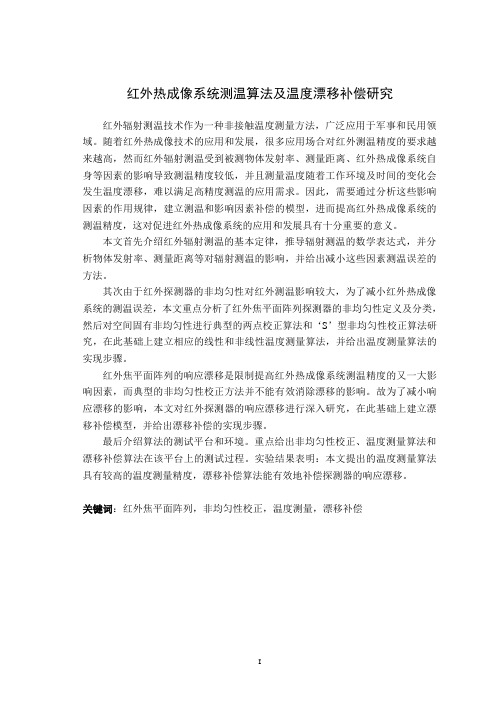
红外热成像系统测温算法及温度漂移补偿研究红外辐射测温技术作为一种非接触温度测量方法,广泛应用于军事和民用领域。
随着红外热成像技术的应用和发展,很多应用场合对红外测温精度的要求越来越高,然而红外辐射测温受到被测物体发射率、测量距离、红外热成像系统自身等因素的影响导致测温精度较低,并且测量温度随着工作环境及时间的变化会发生温度漂移,难以满足高精度测温的应用需求。
因此,需要通过分析这些影响因素的作用规律,建立测温和影响因素补偿的模型,进而提高红外热成像系统的测温精度,这对促进红外热成像系统的应用和发展具有十分重要的意义。
本文首先介绍红外辐射测温的基本定律,推导辐射测温的数学表达式,并分析物体发射率、测量距离等对辐射测温的影响,并给出减小这些因素测温误差的方法。
其次由于红外探测器的非均匀性对红外测温影响较大,为了减小红外热成像系统的测温误差,本文重点分析了红外焦平面阵列探测器的非均匀性定义及分类,然后对空间固有非均匀性进行典型的两点校正算法和‘S’型非均匀性校正算法研究,在此基础上建立相应的线性和非线性温度测量算法,并给出温度测量算法的实现步骤。
红外焦平面阵列的响应漂移是限制提高红外热成像系统测温精度的又一大影响因素,而典型的非均匀性校正方法并不能有效消除漂移的影响。
故为了减小响应漂移的影响,本文对红外探测器的响应漂移进行深入研究,在此基础上建立漂移补偿模型,并给出漂移补偿的实现步骤。
最后介绍算法的测试平台和环境。
重点给出非均匀性校正、温度测量算法和漂移补偿算法在该平台上的测试过程。
实验结果表明:本文提出的温度测量算法具有较高的温度测量精度,漂移补偿算法能有效地补偿探测器的响应漂移。
关键词:红外焦平面阵列,非均匀性校正,温度测量,漂移补偿第一章绪论1.1红外热成像技术的概述德国物理学家霍胥尔于1800年在太阳光线中发现了红外线,它是众多不可见光线中的一种,又称为红外热辐射。
红外热辐射作为自然界最广泛的电磁辐射,任何物体只要其表面温度高于绝对零度(-273.15℃)都会不断的向外释放红外辐射错误!未找到引用源。
红外测温及热成像方案
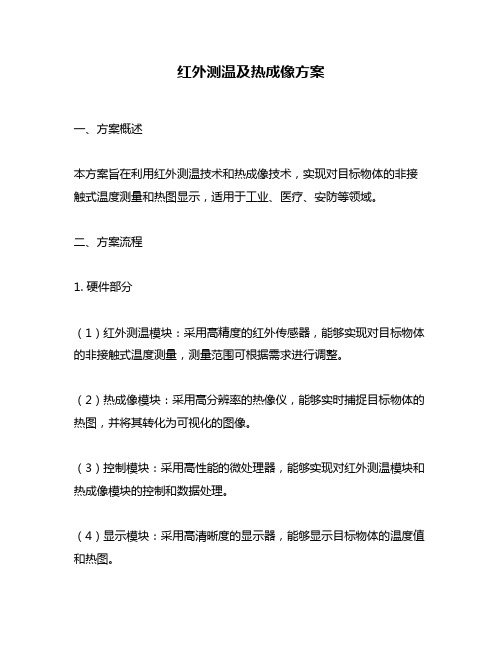
红外测温及热成像方案一、方案概述本方案旨在利用红外测温技术和热成像技术,实现对目标物体的非接触式温度测量和热图显示,适用于工业、医疗、安防等领域。
二、方案流程1. 硬件部分(1)红外测温模块:采用高精度的红外传感器,能够实现对目标物体的非接触式温度测量,测量范围可根据需求进行调整。
(2)热成像模块:采用高分辨率的热像仪,能够实时捕捉目标物体的热图,并将其转化为可视化的图像。
(3)控制模块:采用高性能的微处理器,能够实现对红外测温模块和热成像模块的控制和数据处理。
(4)显示模块:采用高清晰度的显示器,能够显示目标物体的温度值和热图。
2. 软件部分(1)数据采集:通过控制模块对红外测温模块和热成像模块进行控制,实现对目标物体的温度和热图数据的采集。
(2)数据处理:通过微处理器对采集到的数据进行处理,计算出目标物体的温度值和热图。
(3)数据显示:将处理后的数据通过显示模块进行显示,实现对目标物体的温度值和热图的实时显示。
三、方案优势1. 非接触式测量:采用红外测温技术,能够实现对目标物体的非接触式温度测量,避免了传统测温方式中可能存在的接触污染和误差。
2. 高精度测量:采用高精度的红外传感器和热像仪,能够实现对目标物体的高精度温度测量和热图捕捉。
3. 实时显示:采用高性能的微处理器和显示器,能够实现对目标物体的温度值和热图的实时显示,方便用户进行实时监测和分析。
4. 多领域应用:本方案适用于工业、医疗、安防等领域,能够满足不同领域的温度测量和热图显示需求。
四、方案应用1. 工业领域:可用于工业生产中的温度监测和热图分析,如机械设备的温度监测、电子元器件的热分布分析等。
2. 医疗领域:可用于医疗诊断中的体温测量和热图分析,如对病人的体温监测、对病灶的热分布分析等。
3. 安防领域:可用于安防监控中的人体温度检测和热图分析,如对人员的体温监测、对异常热源的检测等。
五、方案总结本方案采用红外测温技术和热成像技术,实现对目标物体的非接触式温度测量和热图显示,具有高精度、实时显示、多领域应用等优势,适用于工业、医疗、安防等领域。
红外测温及热成像方案

红外测温及热成像方案红外测温及热成像技术是一种基于物体发射红外辐射的测温方法,通过红外相机采集红外图像,并通过图像处理算法转化为温度分布图像。
这一技术在工业、医疗、建筑等领域具有广泛的应用前景。
红外测温的原理是利用物体发射红外辐射与温度成正比的特性。
物体的温度越高,其发射的红外辐射也越强。
红外相机能够感知物体发射的红外辐射,并将其转化为数字图像。
通过对图像进行处理和分析,可以得到物体表面的温度分布情况。
红外测温技术具有许多优势。
首先,它可以在非接触的情况下进行测温,避免了传统接触式测温中可能带来的交叉感染风险。
其次,红外测温速度快,可以实现对大面积物体的快速测温。
同时,红外测温技术还具有高精度、高灵敏度的特点,能够对微小温度变化做出准确的测量。
在工业领域,红外测温及热成像技术广泛应用于设备状态监测和故障诊断。
例如,在电力行业中,通过红外测温可以实时监测电力设备的温度变化,及时发现异常情况并进行维修。
在制造业中,红外测温可以用于监测设备的运行状况,提前预警可能出现的故障。
在医疗领域,红外测温技术被广泛用于体温测量。
相比传统的体温计,红外测温可以在非接触的情况下快速测量体温,避免了交叉感染的风险。
同时,红外测温还可以用于监测疾病患者的病情变化,提供及时的医疗干预。
在建筑领域,红外测温技术可以用于建筑结构的检测和维护。
通过对建筑物表面的温度分布进行监测,可以及时发现结构缺陷和隐患,防止事故的发生。
同时,红外测温还可以用于监测建筑物的能耗情况,优化能源利用,降低能源消耗。
红外测温及热成像技术在各个领域都有着广泛的应用前景。
通过利用物体发射的红外辐射进行温度测量,红外测温技术可以实现非接触、快速、准确的测温。
在工业、医疗、建筑等领域的应用中,红外测温技术可以提高工作效率,降低风险,为人们的生活和工作带来更多便利。
发电行业热成像测温系统解决方案
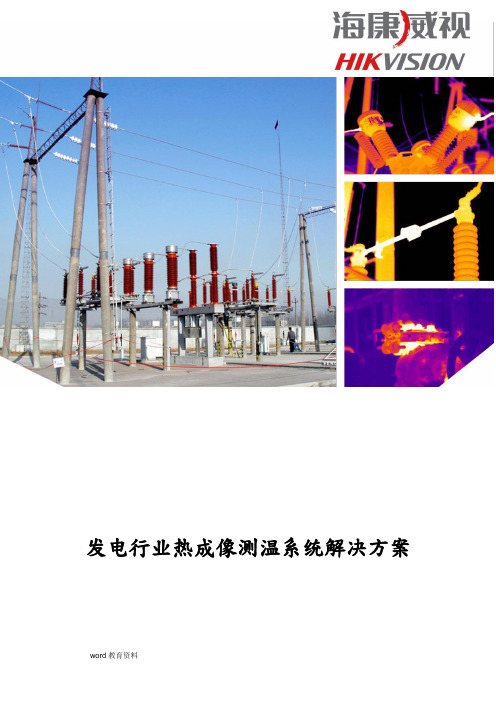
发电行业热成像测温系统解决方案目录第一章背景及需求 (6)1.1应用背景 (6)1.2业务现状 (6)1.3需求分析 (7)1.3.1业务需求 (7)1.3.2系统需求 (7)1.4总体目标 (7)第二章系统总体思路 (8)2.1设计原则 (8)2.2设计依据 (9)2.3设计思路 (9)第三章系统总体设计 (11)3.1总体架构 (11)3.1.1系统拓扑 (11)3.1.2系统组成 (12)3.2系统功能 (13)3.2.1基础功能 (13)3.2.2特色功能 (16)3.3系统特点 (18)3.3.1精确测温 (18)3.3.2全区域无死角 (19)第四章前端系统 (21)4.1设计思路 (21)4.2前端部署 (21)4.2.1水电站风洞层 (21)4.2.2水电站、抽蓄电站出线场 (24)4.2.3水电、抽蓄、火电电缆测温 (26)4.2.4主变压器测温 (27)第五章中心系统 (29)5.1存储系统 (29)5.1.1 NVR存储 (29)5.1.2 CVR存储 (29)5.1.3存储容量计算 (30)5.2解码拼接系统 (31)5.2.1解码器 (31)5.2.2图像处理器 (34)5.2.3视频综合平台 (35)5.3大屏幕显示系统 (36)5.3.1 LCD显示单元 (38)5.3.2 DLP显示单元 (39)5.3.3 LED显示单元 (40)第六章传输系统 (42)6.1.1设计思路 (42)6.1.2设计要求 (42)6.2网络详细设计 (44)6.2.1网络结构设计 (44)6.2.2组网方式 (46)6.2.3 VLAN规划 (48)6.2.4网络IP地址规划 (49)6.2.5路由总体规划 (50)6.2.6网络传输带宽要求 (51)6.2.7网络可靠性设计 (52)6.2.8网络安全性设计 (53)6.2.9网络管理规划 (54)附录A 关键设备介绍 (56)第一章背景及需求1.1 应用背景发电行业电气设备运行异常易造成设备跳闸、损坏,严重的导致机组非计划停运,人员与财产损失。
电气设备红外热成像测温检测程序
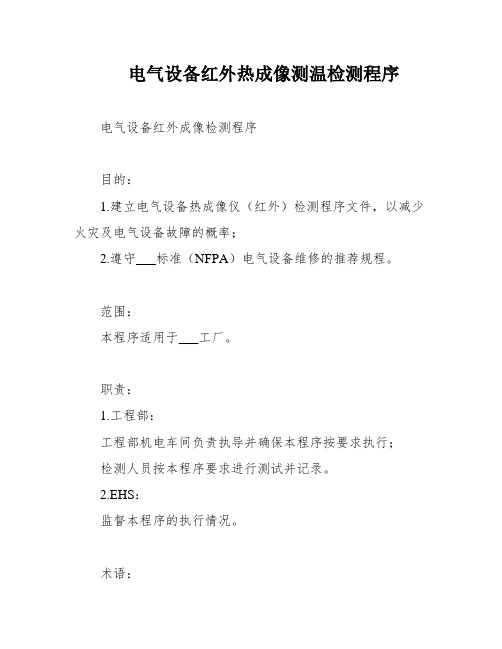
电气设备红外热成像测温检测程序电气设备红外成像检测程序目的:1.建立电气设备热成像仪(红外)检测程序文件,以减少火灾及电气设备故障的概率;2.遵守___标准(NFPA)电气设备维修的推荐规程。
范围:本程序适用于___工厂。
职责:1.工程部:工程部机电车间负责执导并确保本程序按要求执行;检测人员按本程序要求进行测试并记录。
2.EHS:监督本程序的执行情况。
术语:1.红外热成像测温仪:一种非接触式的测温设备,通过探测器探测红外(热)能,并将其转化成电子信号加以处理,进而在视频显示器生成热图像。
2.___:被测设备表面温度和环境温度参照体表面温度之差。
3.温差:不同被测设备或同一被测设备不同部位之间的温度差。
4.相对温差:两个对应测点之间的温差与其中较热点的温升之比的百分数。
相对温差δ可用下式求出:δ=(ζ1-ζ2)/ζ1×100%=(T1-T2)/(T1-T)×100%式中:ζ1和T1——发热点的温升和温度;ζ2和T2——正常相对应点的温升和温度;T0——环境温度参照体的温度。
5.环境温度参照体:用来采集环境温度的物体,具有与被测设备相似的物理属性,并与被检测设备处于相似的环境之中。
6.电压致热型设备:由于电压效应引起发热的设备。
7.电流致热型设备:由于电流效应引起发热的设备。
相关文件:1.Fluke TiS40/TiS45红外热像仪培训资料;3.GB/T 《高压开关设备和控制设备标准的共同技术要求》。
程序:1.红外热成像测温仪概要性说明:红外热成像测温仪是基于物体发射的红外线(如:热)转换成有颜色的图像的原理工作的。
一般来说,图像可以清楚地显现出物体异常热辐射(如:电接触不良的点)。
电气设备的红外热成像测温仪检测是一种很有效的、相对廉价的测试方法。
可以预测电气设备故障以及潜在危害。
同时,检测也可以作为新电气设备验收的一个内容。
红外热成像测温仪检测只能扫描电气设备的可见运行部分(如:电气设备上可以观察到的在负载下的元件等)。
热成像人体测温系统参数

热成像人体测温系统参数1.测温范围:热成像人体测温系统的测温范围通常在-20℃至200℃之间,可以满足不同环境和应用的需求。
2.温度分辨率:热成像人体测温系统的温度分辨率通常在0.1℃至0.2℃之间,可以非常精确地测量人体的温度,避免了传统温度计的误差。
3.测温距离:热成像人体测温系统的测温距离取决于红外热像仪的焦点长度,一般在0.5米至2米之间。
适当的测温距离可以保证测温的有效性和准确性。
4.测温时间:热成像人体测温系统通常能在0.5秒至2秒内完成一次测温。
快速的测温时间使得该系统可以应用于人员密集场所,迅速筛查出潜在的热源。
5.精度误差:热成像人体测温系统的温度测量精度在±0.3℃以内,这个精度误差足够满足一般的体温检测要求。
6.设备分辨率:热成像人体测温系统的设备分辨率通常在320x240至640x480之间,高分辨率的热成像系统可以提供更为清晰和细腻的图像。
7.图像显示:热成像人体测温系统通常采用彩色液晶显示屏,可以清晰地显示出人体的热像图像,并提供数字温度显示。
8.数据传输:热成像人体测温系统可以通过USB接口或Wi-Fi无线传输数据,实现与计算机或移动设备的连接和数据传输。
9.功耗:热成像人体测温系统的功耗通常在2W至5W之间,功耗低的系统节省能源,同时也可以避免过高的热量对人体的干扰。
10.外观设计:热成像人体测温系统通常采用手持式设计,便于携带和操作。
同时,一些系统还设计了防尘、防水等特性,提高了设备的实用性和耐用性。
11.配套软件:热成像人体测温系统通常配套有专用的软件,可以对测温结果进行分析、记录和保存,方便后续的统计和数据分析。
12.应用领域:热成像人体测温系统广泛应用于交通、公共场所、企事业单位、医疗机构等地方,用于安全检查、体温筛查、疫情防控等方面。
总结:热成像人体测温系统是一种高效、准确的体温检测设备,具有测温范围广、温度分辨率高、测温距离远、测温时间快、精度误差低等优点。
红外测温算法——最终版
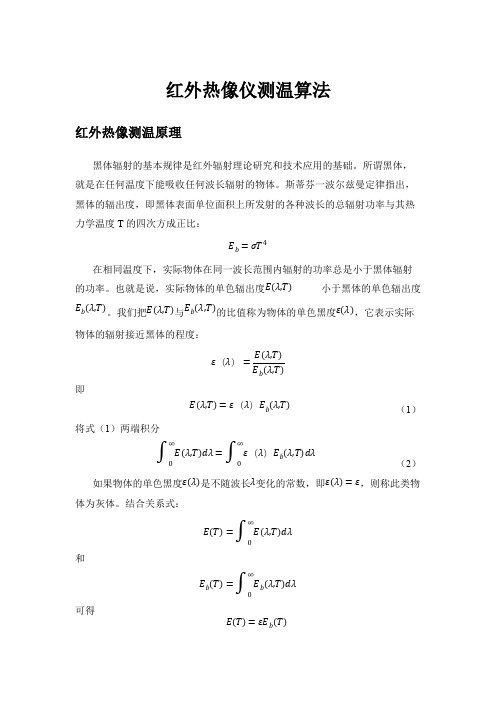
红外热像仪测温算法红外热像测温原理黑体辐射的基本规律是红外辐射理论研究和技术应用的基础。
所谓黑体,就是在任何温度下能吸收任何波长辐射的物体。
斯蒂芬一波尔兹曼定律指出,黑体的辐出度,即黑体表面单位面积上所发射的各种波长的总辐射功率与其热力学温度T 的四次方成正比:E b =σT 4在相同温度下,实际物体在同一波长范围内辐射的功率总是小于黑体辐射的功率。
也就是说,实际物体的单色辐出度小于黑体的单色辐出度E(λ,T)。
我们把与的比值称为物体的单色黑度,它表示实际E b (λ,T)E(λ,T)E b (λ,T)ε(λ)物体的辐射接近黑体的程度:ε(λ)=E(λ,T)E b (λ,T)即(1)E (λ,T )=ε(λ)E b (λ,T)将式(1)两端积分(2)∫∞0E (λ,T )dλ=∫∞0ε(λ)E b (λ,T)dλ如果物体的单色黑度是不随波长变化的常数,即,则称此类物ε(λ)λε(λ)=ε体为灰体。
结合关系式:E (T )=∫∞E (λ,T )dλ和E b (T)=∫∞0E b (λ,T)dλ可得E (T )=εE b (T)所以(3)E b =εσT 4实际物体的热辐射在红外波长范围内,可以近似地看成灰体辐射。
被定义ε为物体的发射率。
表明该物体的辐射本领与同温度同测量条件下的黑体辐射本领之比。
式(3)正是红外测温技术的理论依据。
作用于热像仪的辐射照度为(4)E λ=A 0d ‒2[τaλελL bλ(T 0)+τaλ(1‒αλ)L bλ(T u )+εaλL bλ(T a )]其中, 为表面发射率, 为表面吸收率, 为大气的光谱透射率,ελαλτaλ为大气发射率, 为被测物体表面温度, 为环境温度, 为大气温度,εaλT 0T u T a d 为该目标到测量仪器之间的距离,通常一定条件下, 为一个常值,A 0d ‒2为热像仪最小空间张角所对应的目标的可视面积。
热像仪通常工作在某一个A 0很窄的波段范围内,或之间,、、通常可认为与无关。
- 1、下载文档前请自行甄别文档内容的完整性,平台不提供额外的编辑、内容补充、找答案等附加服务。
- 2、"仅部分预览"的文档,不可在线预览部分如存在完整性等问题,可反馈申请退款(可完整预览的文档不适用该条件!)。
- 3、如文档侵犯您的权益,请联系客服反馈,我们会尽快为您处理(人工客服工作时间:9:00-18:30)。
现在不管在哪里都离不开测体温这件事,如果在一些人群比较密集的地方,只用传统的测温枪,效率比较慢,所以现在很多地方都开始采用热成像测温系统。
1、人体测温热像仪
推荐场景:医院、学校、公安、政府、企业园区、机场、火车站、客运站、地铁站等安检入口临时布控、利旧改造。
系统组成:系统由前端人体测温系统和后端视频存储服务器或管理软件组成。
前端人体测温系统包括人体测温热像仪和高精度人体测温黑体;后端包括智能视频存储服务器(I系列NVR)或者现场电脑安装4200客户端管理软件。
系统功能:通过热成像摄像机(非接触式方式),初步对进入测温范围的人员进行人体温度检测。
如发现温度异常个体,热成像摄像机触发声光报警(外接声光报警),提醒现场工作人员进一步处置。
系统优势:
1、智能补偿:可根据环境参数自动补偿测温结果,保障测温精度与筛检率;
2、人脸检测测温:可有效排除非测温目标干扰;
3、人证合一:可快速锁定体温异常目标的身份,提高事前预警、事中处理、
事后追溯的工作效率。
方案清单:人体测温套装(含黑体) + 两个三角架+ 电脑+ iVMS-4200客户端
活体手持测温筛查方案系统组成
为了便于执法人员机动灵活的对各个通道口的人员进行实时检查。
系统设计采用活体手持测温热像仪对待检人员进行测温,快速查看图像和数据。
推荐场景:高速出口、车厢、机舱等灵活巡检
方案清单:活体手持测温热像仪(可根据需要选配三角架)
方案优势:
1、经济实用,灵活巡检:针对突发事件可在固定出入口快速投入使用
2、测温精度保证:±0.3℃精度(10~35℃),满足体温初筛需求。
热成像测温系统的使用提高了工作人员的检测效率,现在逐步应用在了地铁、汽车站、火车站等地,如果大家有需要安装该系统,成都慧翼科技建议大家找专业的人员来安装。
